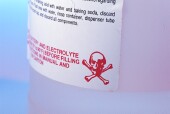
MONDAY, Dec. 17 (HealthDay News) — Injuries to U.S. children from consuming caustic chemicals — like those in some drain cleaners and cleaning products — have dropped sharply, a new report finds.
However, while efforts to improve the safety of household cleaners seem to be paying off, hundreds of children are still injured each year, and their care costs millions of dollars, the researchers added.
“The legislation that’s been enacted has been successful, and we’ve definitely seen a decrease in the number of injuries that occur, particularly the ones that require admission. But there’s still a significant economic and hospital burden,” said report co-author Dr. Matthew Brigger, chief of pediatric otolaryngology at the Naval Medical Center in San Diego.
Caustic chemicals give scrubbing power to a variety of household products, such as certain kitchen cleaners, drain cleaners, oven cleaners, toilet-bowl cleaners and powdered dishwasher detergent. They’re also found in hair-relaxing products.
The problem is that the chemicals are so powerful that they can cause injuries similar to burns in children who consume them, said Dr. Shan Yin, medical director of the Cincinnati Drug and Poison Information Center.
Decades ago, children were often injured by lye, a caustic chemical used to make soap. The federal government required labeling on caustic products in 1927, and in 1970 it required childproof containers and better labeling.
The authors of the report launched their research because there’s been little recent information about the poisoning of kids with caustic chemicals, Brigger said. Studies from decades ago put the number of poisonings at 5,000 to 15,000 a year, he said.
The researchers looked at a 2009 federal database of hospital treatments of children. They estimated that 807 children were treated for injuries from caustic chemicals. Almost 60 percent of the kids were under the age of 4.
The report estimates that the treatment of the injuries cost more than $22 million in 2009. Most of the children (43 percent) required examinations via esophagoscopy, a procedure that examines the esophagus.
Physicians treat children with injuries from caustic chemicals by monitoring the damage and keeping an eye out for infection and scarring, said Yin.
In the big picture, the study shows that legislation to prevent injuries from caustic chemicals has been successful, Brigger said. Still, parents need to keep dangerous cleaning products away from children, preferably in high places and in locked storage containers, he said.
Yin said parents should also be careful about what they pour cleaning products into. “A common story we hear is that someone will pour them into something else, like a Gatorade bottle. You’ve defeated the child-resistant container, and you’ve put it into something that people normally drink from.”
The study appears in the December issue of the Archives of Otolaryngology — Head & Neck Surgery.
More information
The Children’s Hospital of Philadelphia has details about poisoning from caustic chemicals.

